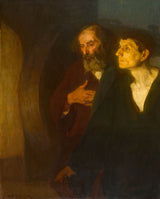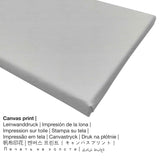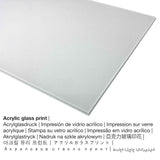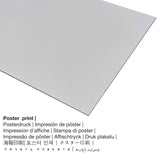Henrijs Osava Tanners, 1906. gads - divi mācekļi pie kapa - tēlotājas mākslas druka
PVN iekļauts. Piegāde aprēķināta Pie izrakstīšanās
Informācija par rakstu
In 1906 the artist Henry Ossawa Tanner created the masterpiece. The piece of art had the following size - 129,5 × 105,7 cm (51 × 41 7/8 collas). Eļļa uz audekla was applied by the North American artist as the medium of the piece of art. The original masterpiece has the following inscription: signed, lower left: "H.O. Tanner". Turklāt šis mākslas darbs atrodas Čikāgas Mākslas institūts art collection. The modern art public domain artpiece is provided with courtesy of Čikāgas Mākslas institūts. Turklāt mākslas darbam ir šāda kredītlīnija: Roberta A. Vallera fonds. Turklāt notiek digitālās reproducēšanas izlīdzināšana portrets formāts un tā attiecība ir 1: 1.2, kas to nozīmē garums ir par 20% īsāks nekā platums.
Kāds būtu jūsu iecienītākais produkta materiāls?
The product dropdown menu ofers you the possibility to choose your prefered size and material. Choose among the following product options now to match your preferences in size and material:
- Plakāts (audekla materiāls): The poster is a UV printed sheet of flat cotton canvas with a slightly rough structure on the surface, that resembles the actual masterpiece. Please note, that depending on the size of the poster we add a white margin of approximately 2-6cm round about the painting to facilitate the framing with a custom frame.
- Alumīnija dibondraksts (metāls): Aluminium Dibond prints are prints on metal with an impressive effect of depth - for a modern look and a non-reflective surface structure. A direct Direct Print on Aluminum Dibond is the ideal introduction to art reproductions on aluminum. The colors are bright and vivid in the highest definition, fine details of the print are crisp.
- Audekls: A canvas print is a printed cotton canvas mounted on a wood stretcher. A canvas makes the exclusive impression of three-dimensionality. Your canvas of this masterpiece will let you turn your custom art print into a large artwork as you know from art galleries. How do I hang a canvas on the wall? The great advantage of canvas prints is that they are relatively low in weight, which means that it is quite simple to hang the Canvas print without extra wall-mounts. Therefore, a canvas print is suited for all kinds of walls.
- Akrila stikla apdruka: The print on acrylic glass, often denoted as a print on plexiglass, will convert the original artwork into beautiful décor. In addition, it forms a great alternative to dibond or canvas art prints. Your favorite artwork is being custom-made with state-of-the-art UV direct printing machines. The great advantage of an acrylic glass fine art copy is that contrasts and also small image details will be exposed with the help of the fine tonal gradation.
Juridiskā atruna: We try what we can to depict the art products as closely as possible and to display them visually in our shop. At the same time, some pigments of the print products, as well as the print result might vary somehwat from the image on your device's screen. Depending on the settings of your screen and the nature of the surface, colors might not be printed as realisitcally as the digital version on this website. In view of the fact that all art prints are processed and printed by hand, there may as well be minor discrepancies in the motif's exact position and the size.
Izstrādājuma specifikācijas
| Drukas kategorija: | sienas māksla |
| Reprodukcijas metode: | reproducēšana digitālā formātā |
| Ražošanas process: | UV tiešā druka (digitālā druka) |
| Produkta izcelsme: | Vācu ražots |
| Krājumu veids: | produkcija pēc pieprasījuma |
| Paredzētais lietojums: | sienas dekors, sienas māksla |
| Attēla orientācija: | portreta formāts |
| Sānu attiecība: | (garums: platums) 1: 1.2 |
| Attēla malu attiecības ietekmēšana: | garums ir par 20% īsāks nekā platums |
| Pieejamie varianti: | akrila stikla apdruka (ar īsta stikla pārklājumu), plakāta druka (audekla papīrs), audekla apdruka, metāla apdruka (alumīnija dibons) |
| Audekla drukas (audekls uz nestuvju rāmja) varianti: | 50x60cm - 20x24 ", 100x120cm - 39x47", 150x180cm - 59x71 " |
| Akrila stikla apdrukas (ar īstu stikla pārklājumu) iespējas: | 50x60cm - 20x24 ", 100x120cm - 39x47", 150x180cm - 59x71 " |
| Plakātu drukas (audekla papīrs) izmēru varianti: | 50x60cm - 20x24 ", 100x120cm - 39x47" |
| Alumīnija dibondraksts: | 50x60cm - 20x24 ", 100x120cm - 39x47" |
| Mākslas darbu rāmji: | nav rāmja |
Mākslas detaļu gabals
| Mākslas darba nosaukums: | "The Two Disciples at the Tomb" |
| Mākslas darbu klasifikācija: | glezna |
| Kategorija: | modernā māksla |
| Laiks: | 20th gadsimts |
| Gadā: | 1906 |
| Mākslas darba vecums: | ap 110 gadiem |
| Mākslas darba oriģināls: | eļļa uz audekla |
| Mākslas darba oriģināls: | 129,5 × 105,7 cm (51 × 41 7/8 collas) |
| Mākslas darba oriģinālais paraksts: | signed, lower left: "H.O. Tanner" |
| Muzejs: | Čikāgas Mākslas institūts |
| Muzeja atrašanās vieta: | Čikāga, Ilinoisa, Amerikas Savienotās Valstis |
| Tīmekļa URL: | www.artic.edu |
| Mākslas darba licences tips: | publiski |
| Pieklājīgi no: | Čikāgas Mākslas institūts |
| Kredītlīnija: | Roberta A. Vallera fonds |
Informācija par mākslinieku
| Mākslinieks: | Henry Ossawa Tanner |
| Citi vārdi: | Henry Ossawa Tanner, Tanner Henry Ossawa, Henry Owassa Tanner, Tanner Henri Ossawa, Tanner Henry Owassa, Tanner Henri, Tanner |
| Dzimums: | vīrietis |
| Mākslinieka tautība: | Amerikāņu |
| Profesijas: | gleznotājs, universitātes pasniedzējs |
| Mākslinieka valsts: | ASV |
| Mākslinieka klasifikācija: | mūsdienu mākslinieks |
| Nomira gadu vecumā | 78 gadiem |
| Dzimšanas gads: | 1859 |
| Dzimis (vietā): | Pitsburga, Allegheny grāfiste, Pensilvānija, Amerikas Savienotās Valstis |
| Nāves gads: | 1937 |
| Nāves vieta: | Parīze, Ildefransa, Francija |
© Autortiesības | www.artprinta.com (Artprinta)
(© Autortiesības - Čikāgas Mākslas institūts - Čikāgas Mākslas institūts)
The Art Institute acquired The Two Disciples at the Tomb in 1906 after the canvas was declared “the most impressive and distinguished work of the season” at the museum’s annual exhibition of American painting and sculpture. At that time, Henry Ossawa Tanner was at the height of his reputation, enjoying international fame and winning prizes on both sides of the Atlantic. The son of an African American bishop, Tanner was raised in Philadelphia, where he studied with Thomas Eakins before working as an artist and photographer in Atlanta. Repelled by the racial prejudice he encountered in the United States, he chose to spend nearly all of his adult life in France.














